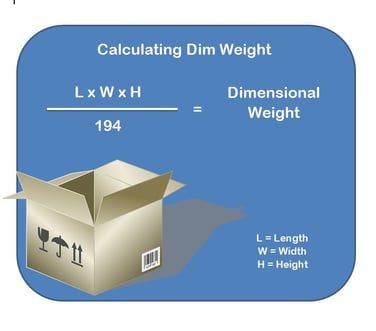The Dim Weight Dilemma
Published by
High Road Inc
on
So what is Dim Weight?
Dim weight, also known as dimensional weight or volumetric weight, is the calculation of a package's volume or density.
In the logistics world, it is often used to help freight companies gain an idea of how much weight will be loaded on a truck, and this helps the businesses and drivers through other processes that occur during the shipping and delivery duration.
Ever since two of the biggest residential and commercial shipping companies, FedEx and UPS, announced in 2015 that they will begin using dim weight to calculate their shipping fees, the country has been up in arms over the issue. Some people believe that shipping and logistics industries are using this calculation method to make more money at the customer’s expense.
However, what many folks shipping freight do not realize is that the dim weight factor has been used throughout the logistics industry for decades. In fact, many residential and commercial shipping as well as 3pl logistics companies are beginning to price their shipping rates based on the dim weight calculation method, as opposed to the actual weight of the package. Even the United States Postal Service uses dimensional weight for shipping large packages.
How is Dim Weight Calculated?
So, how is dim weight calculated? The calculation for ground freight varies slightly from air cargo. Domestic air freight uses the following calculation:
Package’s length multiplied by its width and height then divided by 166. International air dim weight freight calculations are similar, except they use 139 as the divisor. Domestic freight dimensional weight calculations are based on a similar mathematical equation, but industry standards tell us to use 194 as the divisor.
For instance, let’s say we have a client that needs to ship one pallet of pillows from New York City to San Francisco. The dimensions of the skid of pillows measures
19.5 by 9.5 by 9.5 and its actual weight is 6 pounds. According to the industry standard dim weight calculation to ship this pallet of pillows to San Francisco using ground freight, we must first figure out its cubic sized, rounded to the nearest whole number. To do this, first, we round the actual measurements to 20, 10, and 10. Then, we
multiply those numbers together to receive the package’s rounded cubic size: 2,000 cubic inches.
Once we know the cubic inches of the package, we then divide that number by 194 to determine the dimensional weight in pounds: 10.30. Rounded to the nearest whole number, the dim weight of the pallet of pillows is 10 pounds. Champion Logistics uses the standard domestic ground freight dim weight calculation to determine the dimensional weight of the freight we ship.
Why Does Champion Logistics Use Dim Weight?
Throughout the freight shipping and logistics industry, whether a customer is shipping large freight packages and pallets filled with merchandise or simply shipping a package from their house to their friend across the country, shipping and freight companies typically bill using dim weight on packages over 5,000 cubic inches (3 cubic feet or larger).
At Champion Logistics, many of the packages that we ship are significantly larger than this industry standard, which means we must bill shipments based on their dimensional weight.
Dim Weight Made Easy: Introducing Champion Logistics Dim Weight Calculator
We know trying to calculate the dimensional weight of your packages can be
confusing, especially when preparing a freight quote. We strive to improve and maintain communication with their customers, clients, and partners. This is why we have developed the Dim Weight Calculator – so you are never surprised with unexpected shipping costs and know exactly what you are shipping. This free tool will help you make informed decisions on your shipping needs. The Champion Logistics Dim Weight Calculator is an online form that you can download and use anytime, day or night. Using the form is easy: just enter the number of pieces that you want to ship that are about the same size, enter their weight, length, and height measurements, and
enter the actual weight of each piece – then let the calculator do the rest! It will automatically calculate your shipments dimensional weight, taking the guess-work out of shipping for you.



